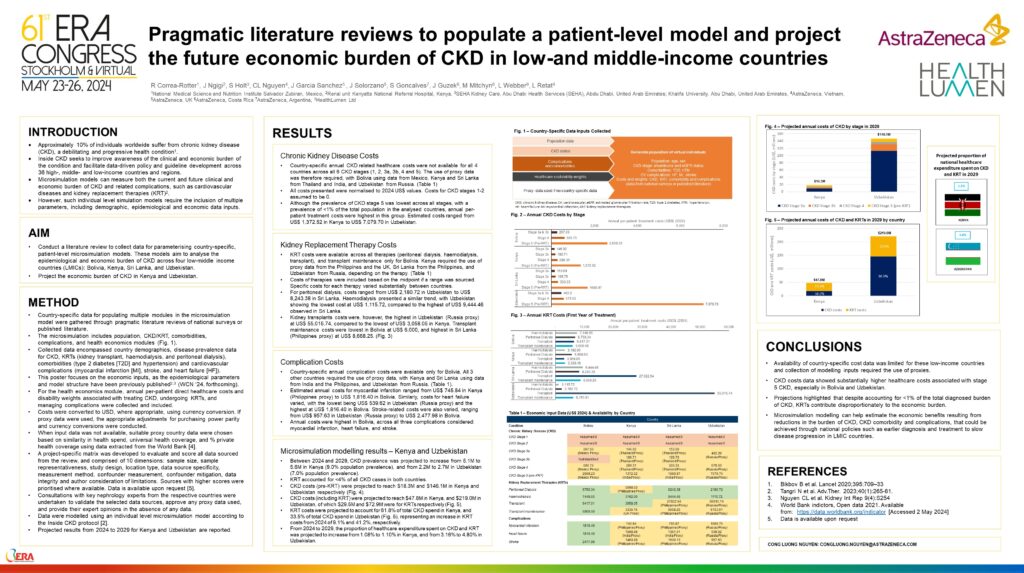
Pragmatic literature reviews to populate a patient-level model and project the future economic burden of CKD in low-and middle-income countries
This poster, presented at the 61st European Renal Association Congress in Stockholm, Sweden (May 23–26, 2024), outlines how pragmatic literature reviews were conducted to populate a patient-level microsimulation model used to project the future economic burden of chronic kidney disease (CKD) in low- and middle-income countries from 2024–2029. Country-specific data collected included country demographics, disease prevalence data for CKD, kidney replacement therapies (KRTs), comorbidities and cardiovascular complications. For the health economics module, annual per-patient direct healthcare costs and disability weights associated with treating CKD, undergoing KRTs, and managing complications were included. Proxy data was used where country-specific data was limited. The results of the microsimulation estimated that by 2029, CKD costs (including KRT) were projected to reach $47.8M in Kenya, and $219.0M in Uzbekistan, of which $29.5M and $72.9M were for KRTs respectively. Such microsimulation modelling can help to estimate the economic benefits that could be achieved in low- and middle-income countries through national policies aiming to reduce CKD burden – including earlier diagnosis and treatment to slow disease progression.
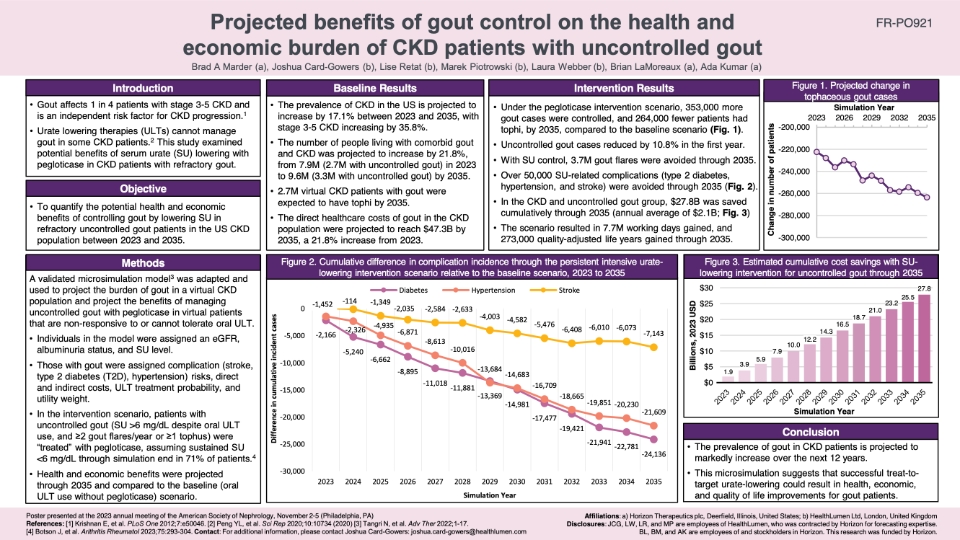
Projected benefits of gout control on the health and economic burden of CKD patients with uncontrolled gout
This poster, presented at the annual meeting of the American Society of Nephrology in Philadelphia, USA (November, 2023) outlines the findings of a study examining the potential benefits of serum urate (SU) lowering using pegloticase in chronic kidney disease (CKD) patients with refractory gout. The study, using microsimulation modelling, found that under a pegloticase intervention scenario, 353,000 more gout cases were controlled, and 264,000 fewer patients had tophi, by 2035, compared to the baseline scenario. Further, the SU lowering intervention was projected to save $27.8B, and gain 7.7M working days, cumulatively through 2035. This study consequently provides evidence that successful treat-to-target urate-lowering could result in health, economic, and quality of life improvements for gout patients.
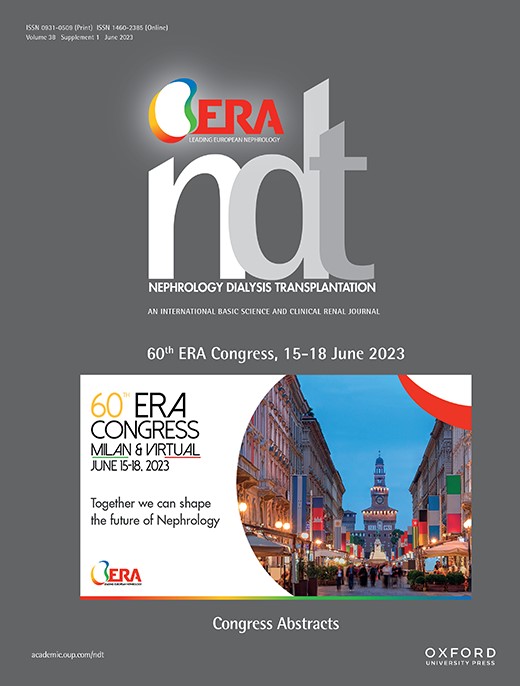
Inside CKD: Projecting the Population Level Clinical Burden of Chronic Kidney Disease According to Urine Albumin-to-Creatine Ratio (uACR) Categories
This study assessed the future epidemiological and financial burden of CKD using the Inside CKD microsimulation. Specifically, it reports on the CKD population level projections for cardio-renal complications, progression to end stage kidney disease (ESKD), and death due to any cause according to uACR categories.
The results support early intervention in the total CKD population, including individuals with normo- or micro-albuminuria, to reduce cardio-renal outcomes, delay progression to ESKD, and therefore avoid the requirement for costly interventions, including heart related hospitalisations, transplantation and dialysis.
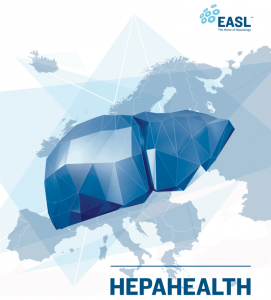
HepaHealth II: Preventing liver disease with policy measures to tackle alcohol consumption and obesity
Chronic liver disease (CLD) causes 1.8% of all deaths in Europe. Without policies to mitigate harmful alcohol consumption and obesity, that proportion will continue to increase. This major study, commissioned by EASL and supported by an unrestricted education grant from Bristol-Myers Squibb and Gilead, was carried out over the past 3 years and estimates the impact of policy interventions targeting alcohol and obesity on the incidence of CLD and primary liver cancer in France, the Netherlands, and Romania. The project builds on our previous work published in 2018.
Our peer-reviewed microsimulation model was employed to project trends in alcohol consumption and body mass index (BMI) from 2022 to 2030. We modelled the incidence of CLD and liver cancer under three policy scenarios versus an inaction scenario. All policies had an important impact ranging from a 2% to 7% reduction in annual incidence of CLD and liver cancer by 2030. The most effective scenarios are an increased Minimum Unit Pricing (MUP) of €1 on alcohol or introducing a set of complementary public health policies targeting an increased MUP, a sugar sweetened beverage (SSB) tax, and a volumetric tax that target both alcohol consumption and obesity.
View the poster presented at the EASL Congress in Vienna (June 2023)
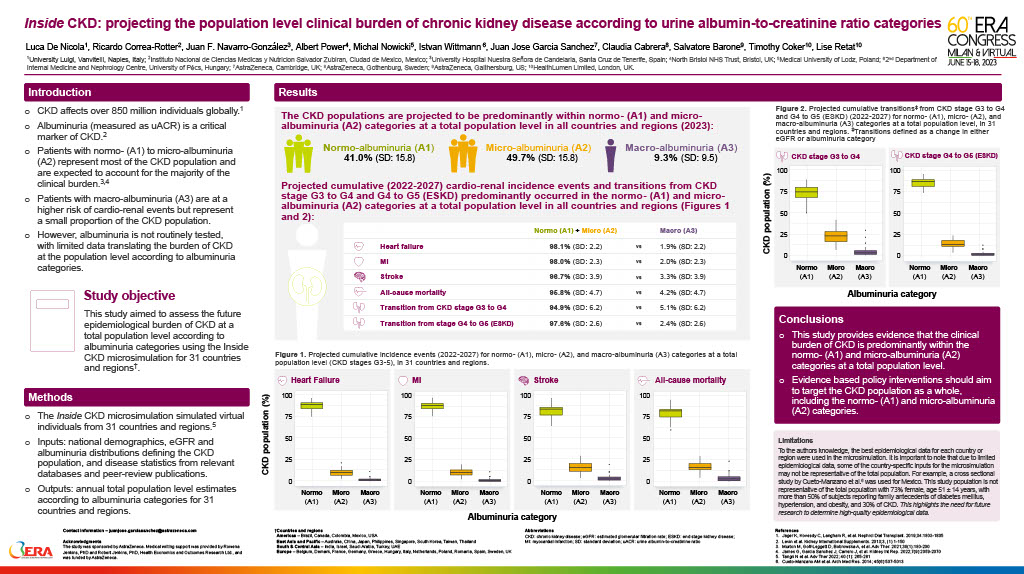
Inside CKD: projecting the population level clinical burden of chronic kidney disease according to urine albumin-to-creatinine ratio categories
This poster, presented at the European Renal Association’s 60th Congress in Milan (June 2023), summarises research on projecting the population level clinical burden of Chronic Kidney Disease (CKD) according to urine albumin-to-creatinine ratio categories. The study provides evidence that the clinical burden of CKD is predominantly within the normo-(A1) and micro-albuminuria (A2) categories at a total population level. Evidence based policy interventions should aim to target the CKD population as a whole, including the normo-(A1) and micro-albuminuria (A2) categories.
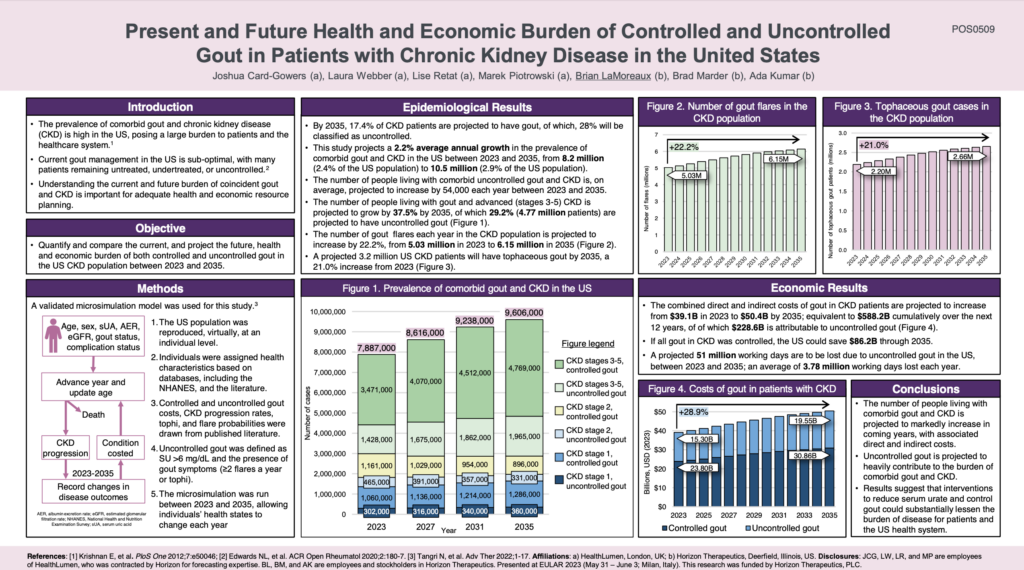
The Present and Future Health and Economic Burden of Controlled and Uncontrolled Gout in Patients with CKD in the US
This poster, presented at EULAR 2023, showcases our new research that projects the increasing health and economic burden of comorbid gout and CKD, in the US, between 2023 and 2035. This study is the first to project the burden of comorbid gout and CKD and highlights the need for strategies that can effectively control gout in CKD patients.
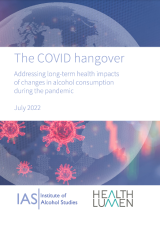
Estimating the long-term health impacts of changes in alcohol consumption in England during the COVID-19 pandemic
Alcohol consumption patterns in England changed during the COVID-19 pandemic. Between one-fifth and one-third of adults increased their alcohol consumption, with a similar proportion drinking less. There was a 20% increase in alcohol-specific deaths in England in 2020 compared with 2019, and this trend persisted through 2021. Alcohol harm includes disease morbidity and mortality, healthcare costs, and wider social consequences. This study aimed to quantify future health, healthcare and economic impacts of changes in alcohol consumption observed during the COVID-19 pandemic using the well-validated HealthLumen microsimulation model.
Three alcohol consumption scenarios were looked at, and in all three the model projected a significant increase in the incident cases of disease, mortality, and healthcare costs. If consumption does not return to 2019 levels or lower, the modelling shows that England could see an additional 147,892 cases and 9,914 additional premature deaths from nine alcohol-related diseases, costing the NHS £1.2bn.
The report concludes that a comprehensive alcohol strategy is needed to harmonise policies across the UK, with a coherent set of evidence-based policies: increased resources for alcohol treatment and support; price interventions through the new alcohol duty system; the introduction of minimum unit pricing in England; adding public health as an objective of the licensing system for alcohol outlets; and improving alcohol marketing regulation, to reduce the reach and appeal of marketing to those vulnerable.
View NIHR Report
View Data Appendix
View Results Appendix
View Technical Appendix
View Policy Report from the Institute of Alcohol Studies
View editorial in the British Journal of Hospital Medicine
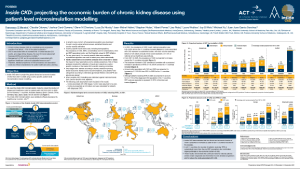
Inside CKD: projecting the economic burden of chronic kidney disease using patient-level microsimulation modelling
As part of the ongoing collaboration between HealthLumen and AstraZeneca to quantify the health and economic burden of Chronic Kidney Disease (CKD), this poster, presented at ISPOR 2021, demonstrates that the burden of CKD is projected to increase by 2026 for all 11 countries included in this analysis. This highlights the need for national policies aimed at early intervention to slow disease progression and reduce healthcare costs.
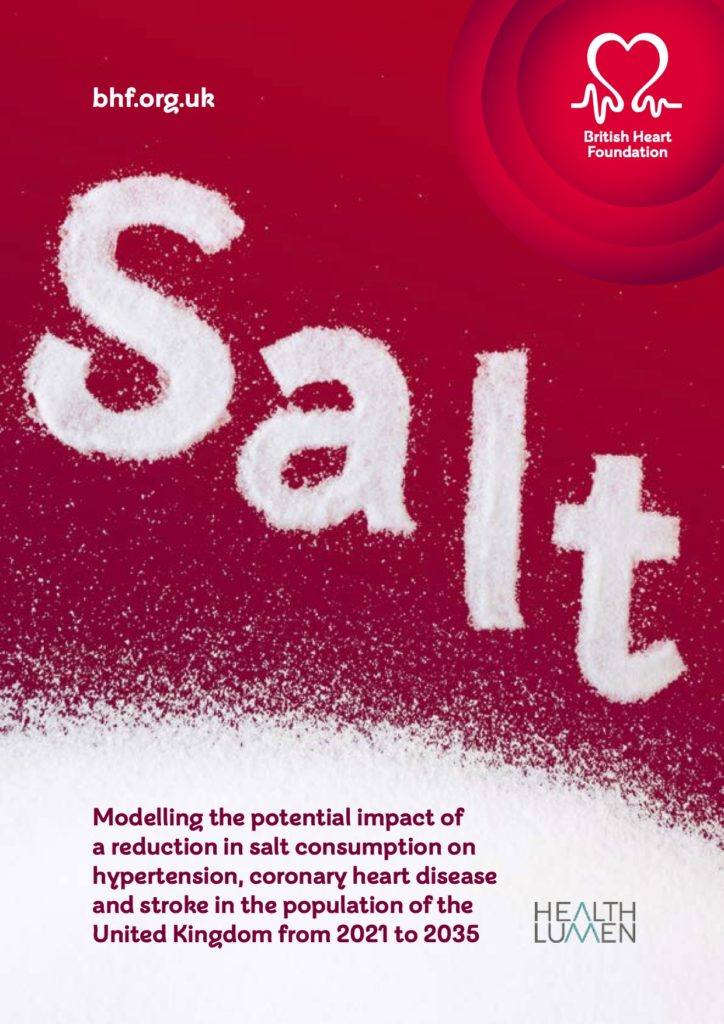
Modelling the potential impact of a reduction in salt consumption on hypertension, coronary heart disease and stroke in the population of the United Kingdom from 2021 to 2035
Poor diet contributes to the high prevalence of hypertension, obesity and non-communicable diseases (NCDs), such as cardiovascular diseases, cancers and diabetes, in Europe. In particular, high levels of salt consumption are harmful to the cardiovascular system. Therefore, a comprehensive strategy to improve diet, including reducing the levels of salt consumption is widely recognised as a strategy to improve health at a population level.
For this study, the British Heart Foundation commissioned HealthLumen to develop a microsimulation model to quantify the significant health and economic benefits that could be achieved by 2035 if UK adult salt consumption was reduced to 6g per day, as per current recommendations, by 2024 and 5g per day by 2030, in line with the WHO target.
Results show that a reduction in salt consumption could attenuate the health and economic burden of hypertension, CHD and stroke. Under the intervention (salt reduction) scenario, we project that 1.4 million fewer people will be living with hypertension in 2035 compared to the baseline scenario. We project that 134,789 cumulative incidences of CHD and 48,540 cumulative incidences of stroke could be avoided by 2035. We project that these reductions will incur direct cost savings of £6.70 billion and indirect cost savings of £4.70 billion between 2021 and 2035.
Given the health and economic benefits that would be generated by a reduction in daily salt consumption, UK Government action that seeks to enforce the national salt reduction policy outlined in this report would contribute significantly to the 2019 NHS target of preventing “up to 150,000 heart attacks, strokes and dementia cases over the next 10 years.”
View blog post
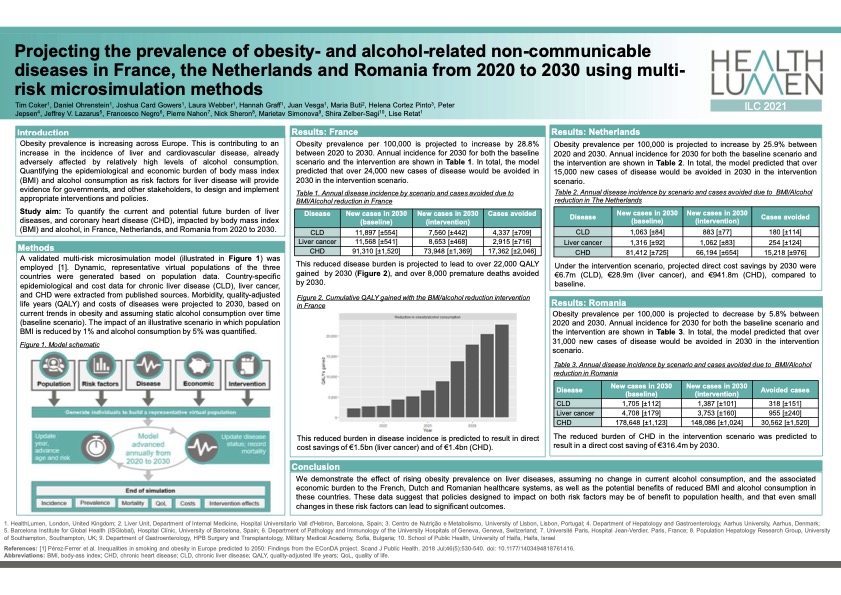
Projecting the prevalence of obesity- and alcohol-related non-communicable diseases in France, the Netherlands and Romania from 2020 to 2030 using multi-risk microsimulation methods
Obesity prevalence is increasing across Europe, which is contributing to an increase in the incidence of liver and cardiovascular disease, already adversely affected by relatively high levels of alcohol consumption. This study demonstrates the effect of rising obesity prevalence on liver diseases, assuming no change in current alcohol consumption, and the associated economic burden to the French, Dutch and Romanian healthcare systems, as well as the potential benefits of reduced BMI and alcohol consumption in these countries. The data suggest that policies designed to impact on both risk factors may be of benefit to population health, and that even small changes in these risk factors can lead to significant outcomes.